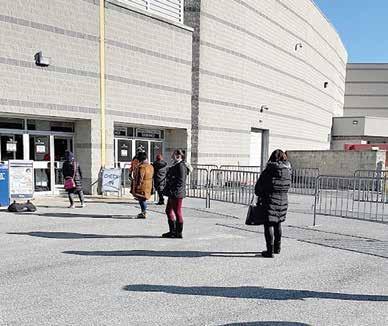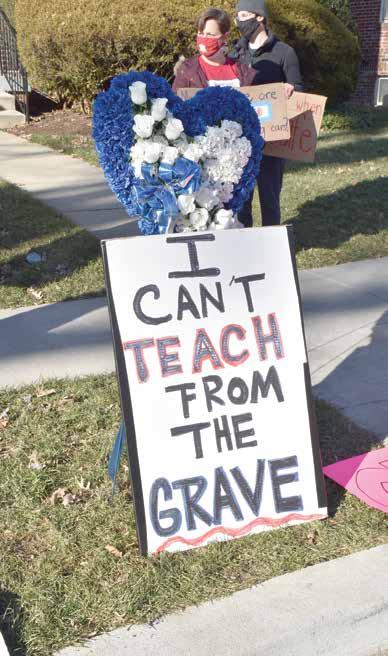
8 minute read
Education
REOPENING from Page 1 vis and DCPS Chancellor Lewis D. Ferebee. include a strike authorization vote later While WTU representatives made this week,” Davis added. nearly a dozen allegations, an arbi-
The tenuous situation came on the trator only found reason to penalize heels of a weekend marked by both a DCPS for failing to honor the portion snowstorm which postponed the re- of the MOA specifying that no school opening of schools by one day and the should reopen without the complecompletion of arbitration proceedings tion of a walk-through and school which found DCPS in violation of at readiness checklist by school officials, least one aspect of the Memorandum an on-campus WTU representative, a of Agreement [MOA] signed by Da- parent and other stakeholders.
WTU acknowledged that walkthroughs took place but raised questions about whether all required parties had been involved or if each school had been thoroughly checked.
Documents secured by The Informer cited situations at Coolidge High School and Capitol Hill Montessori, both located in Northwest, and Watkins Elementary School, located in Northeast, as evidence that DCPS needed to tighten its adherence to protocol.
Per the arbitrator’s ruling, Coolidge and Watkins would not reopen until after another walk-through and the completion of a checklist. DCPS would also be required to provide, within five days, school-by-school family demand data including survey data and information concerning enrollment.
SOME PARENTS STILL APPREHENSIVE ABOUT RETURNING
Even with the one day delay due to the weather, some parents, concerned about the possible spread of COVID-19 in school buildings, have long expressed a commitment to keeping their youngsters at home.
Jamila Hogan said her decision followed recent reports of a COVID-19 case at Langdon Education Campus where her son had been attending a CARE classroom since November. For her, a subsequent exchange, or lack thereof, on social media with Ferebee sealed the deal.
“I’m not sending my son back but I could have if the chancellor had something reassuring to say,” said Hogan, a Northeast resident and parent of a second grader.
Hogan said while she received an email and phone call from school administrators about the COVID-19 case on January 22, administrators didn’t specify which staff member contracted the virus or whether that person had been quarantined. She later recounted learning about another positive case on January 29.
Last Friday, after Ferebee allegedly blocked Hogan on Twitter, she posted screenshots to Instagram showing the notification that her access to the chancellor’s public account had been restricted. Other screenshots showed the letter Langdon parents received earlier in the week and highlighted the questions she asked Ferebee on Twitter about DCPS’ reopening plans.
When Hogan took to Twitter, she asked Ferebee why schools were reopening for Term 3 despite positive COVID-19 cases at Langdon and other CARE classrooms and city officials’ apprehensions about hosting in-person meetings.
“Many other parents at other sites have voiced these concerns but they haven’t been addressed,” she said. “They’ve been blocked [on social media] or ignored. They’ve used the same social media. I expected a better public relations response to explain how they caught [the COVID-19 case at Langdon] and protected everyone,” she added.
TEACHERS ALLEGE A RUSHED PROCESS
As outlined in the MOA, the dozen members of the on-site safety walkthrough team would either sign a school readiness checklist, or notify the school community about the need for a readjustment plan. Less than a week before the start of Term 3, Ferebee told reporters that some schools were still in the midst of walk-throughs.
As of Tuesday, DCPS hasn’t responded to The Informer’s two inquiries about how many of the 117 public school campuses had successfully completed the process. A showcase of safety measures taken at Columbia Heights Education Campus scheduled for that day had also been pushed back to Tuesday morning because of the snow.
Inclement weather notwithstanding, instructor Samantha Brown expressed an unwillingness to return to in-person learning, especially because of what she recounted as a contentious walk-through at Coolidge toward the latter part of January.
The WTU/DCPS arbitration document named Brown as an aggrieved party in the conflict that arose during the walk-through at Coolidge. The document included an allegation that DCPS officials attempted to schedule a second walk-through with her but she experienced an illness. Brown denied that version of events, citing a January 27 email she sent to make her request.
During the nearly two hours that she walked through the Northwest campus on January 25, Brown, an English/special education teacher and WTU executive board member, said DCPS overwhelmingly represented a portion of the group scheduled to tour Coolidge. She later told The Informer that her principal closed parts of the building off to the group and failed to provide a cleaning schedule or documentation of infrastructural upgrades.
Brown said that her field representative wasn’t allowed to attend a closed meeting that took place the following day, during which she brought forth more than two dozen concerns about what she witnessed at the walkthrough.
Despite her principal’s assurance that the violations outlined in a letter to the school community would be addressed, Brown said she didn’t receive any concrete timeline as to when they would be completed.
“It was pretty obvious that [DCPS officials and our principal] were hiding things. They wouldn’t give us any work order or proof of any inspection,” Brown said.
“We couldn't go into the rest of the building. There weren’t social distancing notifications. It’s like they weren’t taking it seriously that we had to notify people about the pandemic and check all areas. They restricted us, even though I brought a copy of the Memorandum of Agreement.”
WI @SamPKCollins
Current D.C. Policy Allows for Subsidies Based on Attendance Only
Sam P.K. Collins WI Contributing Writer
When D.C. began to roll back COVID-19-related restrictions late last year, childcare providers served as a vital resource for essential workers and others who needed adult supervision for their youngsters during the workday.
Nonetheless, according to many early childhood education advocates, many of the District’s more than 400 childcare providers face financial ruin due to a policy that awards subsidies based on attendance rather than enrollment.
And with a growing number of parents still opting to keep their children home due to the ongoing pandemic, the future appears daunting for childcare providers who supply essential early lessons in education whether youth receive instruction virtually or in the classroom.
“If this was like World War II where you could see bombs dropping, then you wouldn’t have little babies going out to a daycare, ” said Dr. Bernida Thompson, founder and principal of Roots Public Charter School, a Northwest-based institution that includes pre-school and elementary grade levels.
Since last March when the District declared a public health emergency, Roots PCS launched its virtual learning component with all of per-pupil funding allocated to the institution for the 2019-2020 academic year remaining intact.
However, upon Roots PCS’ mandatory shift to a hybrid-learning model in November, the amount distributed by the Office of the State Superintendent of Education [OSSE] was reduced by 50 percent of the amount Roots received during the previous year.
Thompson told The Informer that the reduction represents the decision of a parent population in which only one-half have sent their children back to in-class instruction.
“The mayor is not exposing her baby to a daycare/school environment so why are childcare centers penalized for parents preferring to keep their babies home and using remote education?” Thompson asked. “This is not something where people should have to take their babies out into the deadly world of a pandemic. We should keep our babies inside with their parents.”
“In 2021, school is not just brick and mortar. The young people have been using technology. Even before 2021, we saw that ‘Sesame Street’ taught a lot of pre-school children,” she said.
A report compiled by DC Action for Children in November identified OSSE subsidies as a significant source of funding for childcare centers. The report showed that out of the two-thirds of the District’s early childcare centers planning to open, less than 33 percent expected enrollment to reach pre-COVID-19 levels. This rang true for centers serving more than 50 children.
Prior to the pandemic, 258 of the District’s 469 early childcare centers received reimbursements for student subsidies based on attendance.
Though OSSE started doling out subsidies based on enrollment, not attendance, at the start of the pandemic, the office reverted to the original arrangement in November on the condition that the amount given would increase by more than 30 percent, starting in January, to make up for a lower student population.
That rate, set by a formula, would change every three months in alignment with other policies to increase early childcare subsidies, an OSSE official told The Informer.

(Courtesy photo)
CHILDCARE Page 35
A BETTER WAY TO GET THE FUNDS YOU NEED



From a home remodel to a home refinance, a new car purchase and everything in between, we ’ ve got you covered. At United Bank, we lend more than just money. We 'll be with you every step of the way to make sure you get the products you need with the service you deserve.







